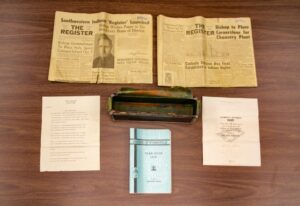By Tim Lilley
The Message editor
Editor’s note: The history of Holy Trinity Parish that was included in the time capsule appears on page 8 of this issue.

On the 64th anniversary of Evansville’s first bishop laying the cornerstone for Holy Trinity Church, which included a time capsule, the sixth bishop of Evansville opened that capsule at the Catholic Center.
Here’s the full story.
About four weeks ago, workers began razing the former Holy Trinity Church in downtown Evansville as part of the Trinity Storm Water Park, a green infrastructure project that will collect stormwater runoff from a 40-60-acre area and keep it from going into the city’s sewer system and ultimately flowing into the Ohio River.
When workers removed the church cornerstone, they quickly noticed a small rectangular box inside – a time capsule!

Measuring 12 inches x 4 inches x 3 inches, the box was made of copper. Its seams, top and bottom, had been soldered to form an airtight seal to protect its contents from as much damage and/or deterioration as possible.
Workers delivered the time capsule to the Diocese of Evansville Catholic Center, and Bishop Joseph M. Siegel opened the capsule and removed its contents on Oct. 19.
The time capsule had been in diocesan possession for a couple of weeks, but Bishop Siegel’s schedule has been packed. He originally planned to open the box on Oct. 23, but the cancellation of an Oct. 19 meeting enabled him to explore the contents of the time capsule a few days early.
That proved to be providential.

Packed tightly into the time capsule were two issues of the Southwestern Indiana Edition of The Register, which had become the diocese’s official weekly newspaper with its Oct. 5, 1956, edition. That paper, Vol. 1, No. 1, and the Oct. 12 edition, Vol.1, No. 2 – were both addressed to then-diocesan-chancellor Monsignor Thomas J. Clarke. Whoever packed the capsule also made room for a copy of the 1956 Diocese of Evansville Yearbook, a one-page history of Holy Trinity Parish (published in full with this story) and a short prayer from John Russell Baker and Associates, the Evansville firm that designed this “replacement” Holy Trinity Church.
Fire, caused by a lightning strike, destroyed the original church on the evening of Palm Sunday in 1950.

The lead story on the front page of the Oct. 12, 1956, issue of The Register was headlined: “Bishop to Place Cornerstone for Chancery Plant.” In addition to the new Holy Trinity Church, the property at Northwest Third and Court Streets in Evansville included a new building to serve as the diocesan chancery. From its founding in 1944 until staff moved into the new chancery in early 1957, diocesan offices and the bishop’s residence had been located at the historic Reitz Home.
Diocesan Chancellor Tim McGuire, Director of Activities and Facilities Andy Reckelhoff and I joined Bishop Siegel for the time-capsule opening. Reckelhoff carefully cut into the soft metal lid of the capsule, ultimately creating an opening big enough for Bishop Siegel to retrieve the contents. We took turns inspecting the contents, and something caught my eye in the lead sentence of a front-page story in The Register: “Cornerstone laying of the new Evansville Diocesan Chancery-Holy Trinity Chapel will be held Friday, Oct. 19, at 3 p.m., with His Excellency, the Most Rev. Henry J. Grimmelsman, S.T.D., officiating.”

Call it a “Whoa Moment.” When we realized that Bishop Siegel had opened the time capsule on the 64th anniversary of its placement with the cornerstone, none of us knew exactly what to say. The timing hadn’t been planned – not by any of us, at least. Now, as in that moment, it seems truly providential.
Churches, lightning and Holy Week
The original Holy Trinity Church – its cornerstone laid in 1849 by Bishop Jacques-Maurice de St. Palais, the fourth bishop of Vincennes – suffered a lightning strike to its tower the night of April 2, 1950, which was Palm Sunday. April 2 was the 14th Sunday of the year 1950.
Just a few miles to the southwest, 48 years and one week earlier, lightning struck one of the towers of the original St. Boniface Church; the resulting fire caused catastrophic damage. That fire happened on Easter Sunday of 1902, which was April 2. It was the 13th Sunday of the year 1902.

